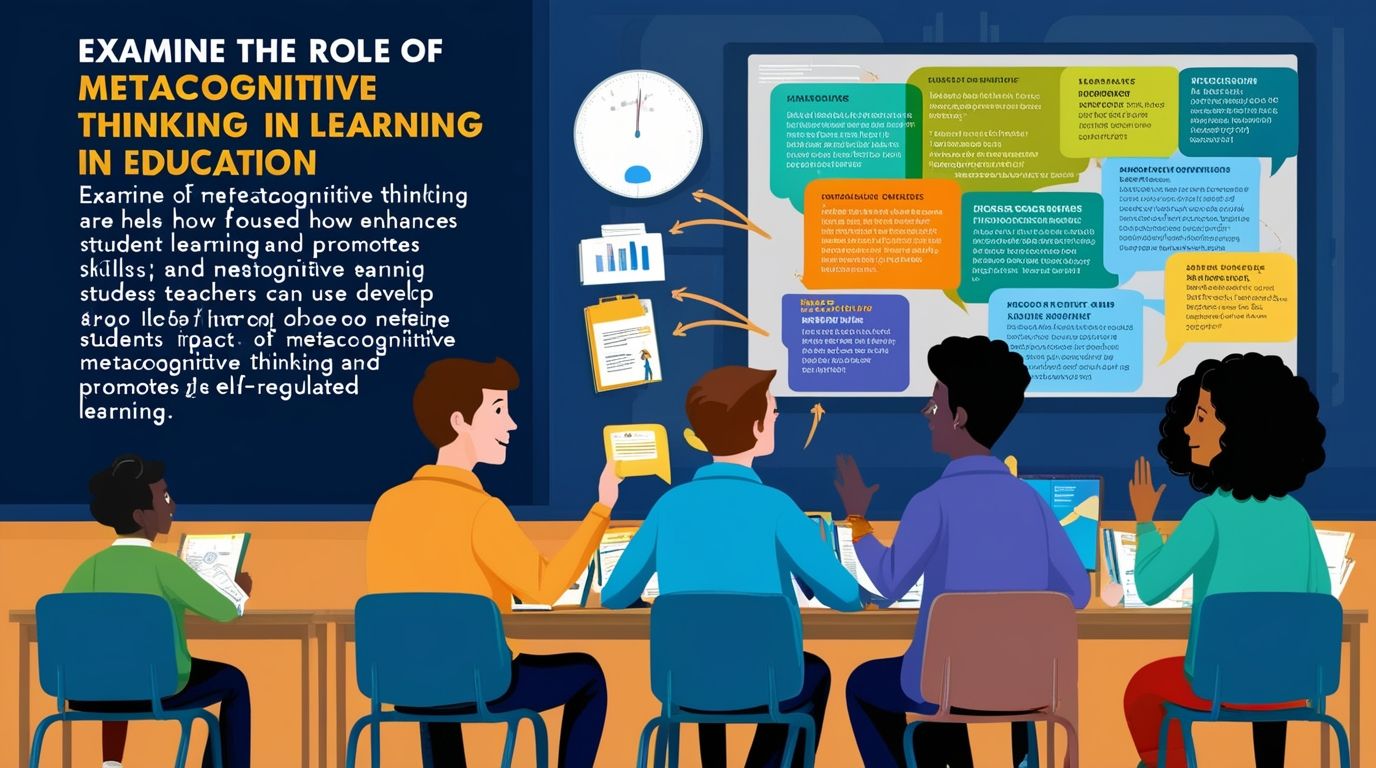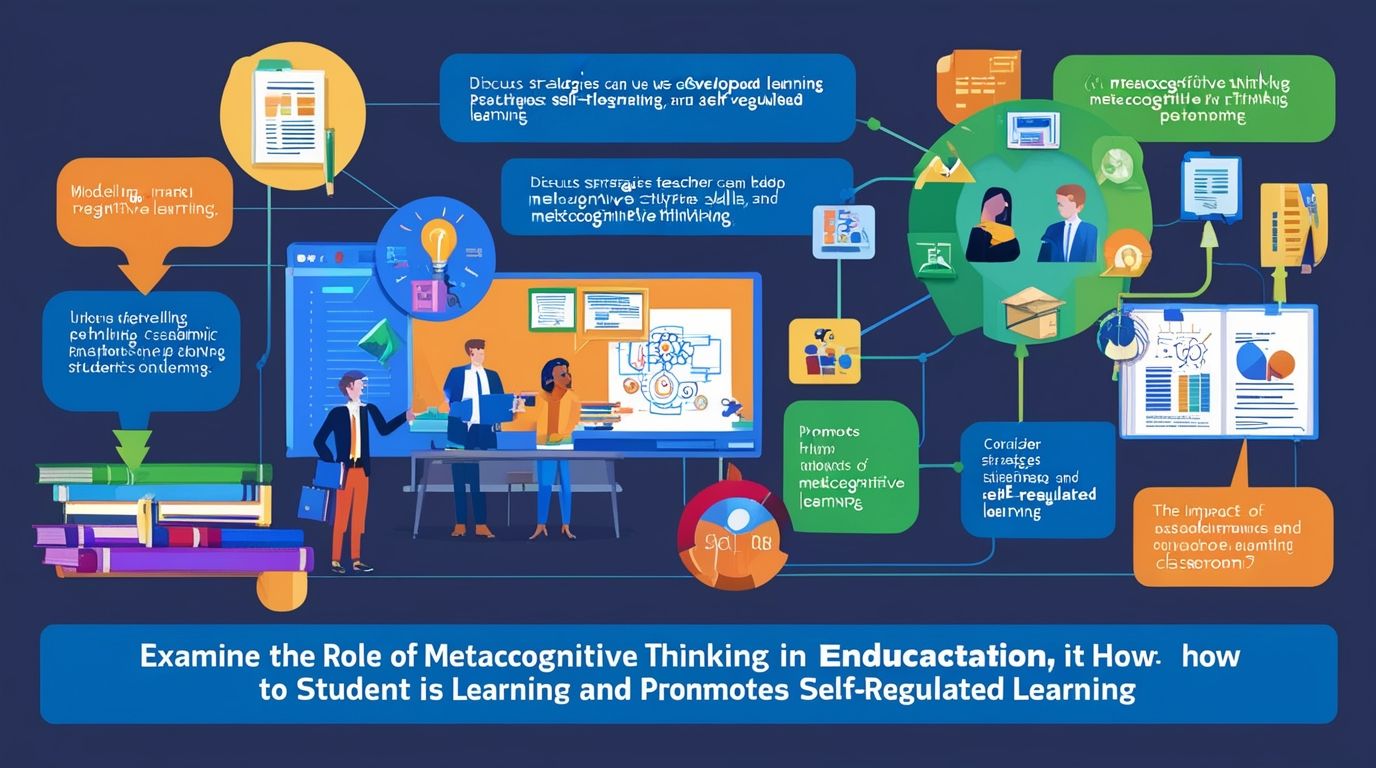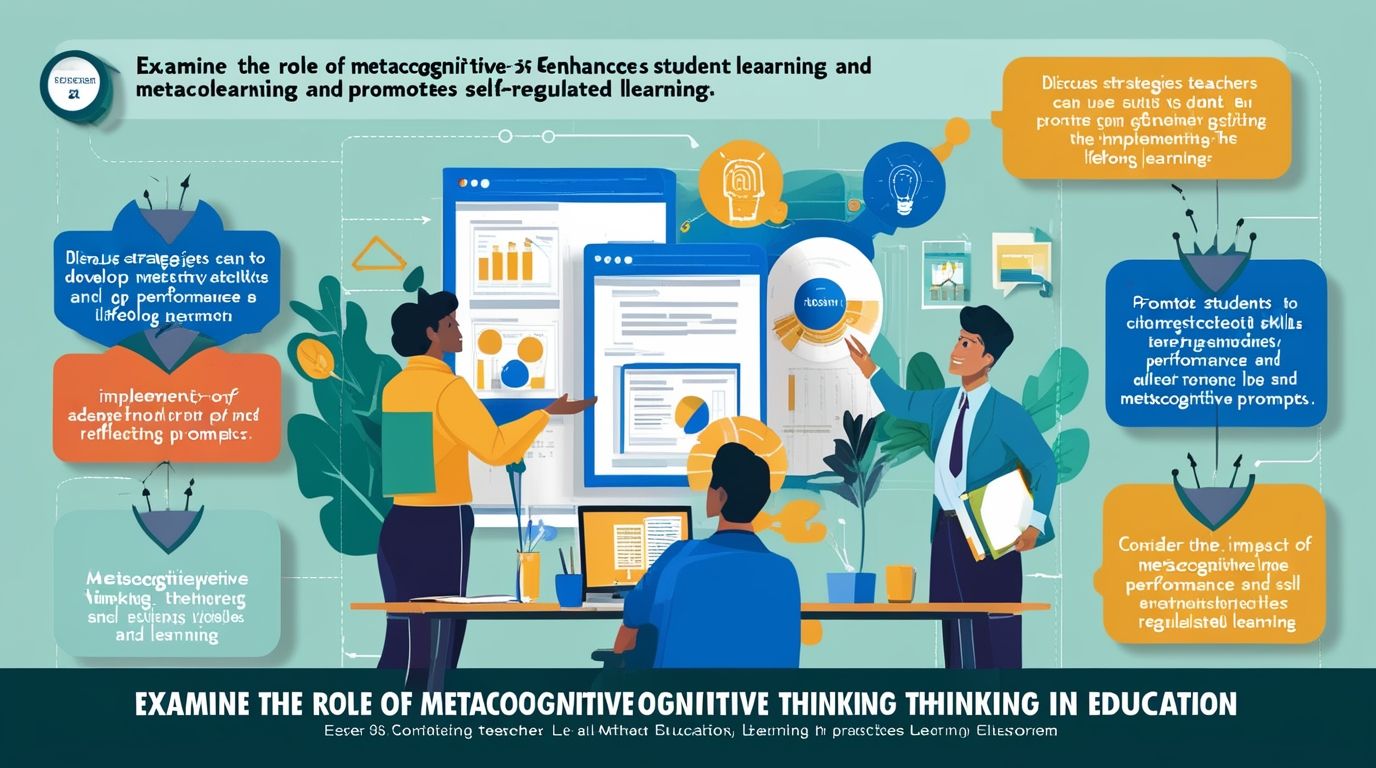Metacognitive Thinking in Education Metacognitive thinking, often described as “thinking about thinking,” plays a pivotal role in education. It encompasses the processes involved in planning, monitoring, and evaluating one’s understanding and learning strategies. Metacognition enables students to become more effective learners and allows educators to foster environments where deeper learning can take place. This article delves into the concept of metacognitive thinking, its importance in education, how it can be developed in students, and the challenges and benefits of integrating metacognition into educational practices.
1. Understanding Metacognitive Thinking
Metacognitive thinking involves two key components: metacognitive knowledge and metacognitive regulation.
- Metacognitive Knowledge: This refers to what individuals know about their cognitive processes. It includes awareness of one’s strengths and weaknesses as a learner, understanding of various strategies for learning, and knowledge about when and how to use these strategies effectively.
- Metacognitive Regulation: This involves the active monitoring and control of cognitive processes during learning. It includes setting goals, selecting appropriate strategies, monitoring progress, and making adjustments as necessary to ensure successful learning outcomes.
These components work together to help learners manage their thinking processes, making learning more efficient and effective.
2. The Importance of Metacognitive Thinking in Education
The development of metacognitive thinking is crucial for several reasons:
2.1 Enhancing Learning and Retention Metacognitive thinking helps students to better understand how they learn and which strategies work best for them. This awareness allows them to tailor their study habits to maximize learning and retention. For example, a student who recognizes that they learn best through visual aids may choose to use diagrams and charts as study tools. This targeted approach enhances both the depth and retention of knowledge.
2.2 Promoting Self-Regulated Learning Self-regulated learning is a process where learners take control of their own learning by setting goals, monitoring their progress, and adjusting their strategies as needed. Metacognitive thinking is at the heart of this process. When students engage in self-regulation, they become more independent learners who are capable of tackling complex tasks and adapting to different learning situations. This autonomy is essential not only for academic success but also for lifelong learning.
2.3 Fostering Critical Thinking and Problem-Solving Skills Metacognition encourages students to think critically about their thought processes. When students reflect on how they approach problems, they can identify more effective strategies and avoid common pitfalls. This reflective practice is essential for developing strong problem-solving skills, as it enables students to approach challenges systematically and with greater insight.
2.4 Encouraging Lifelong Learning In a rapidly changing world, the ability to learn and adapt continuously is crucial. Metacognitive thinking equips students with the tools they need to become lifelong learners. By understanding how they learn and how to adjust their strategies, students are better prepared to acquire new knowledge and skills throughout their lives.

3. Developing Metacognitive Thinking in Students
Teachers play a critical role in helping students develop metacognitive thinking. This development can be fostered through various instructional strategies and classroom practices.
3.1 Teaching Metacognitive Strategies Explicitly One of the most effective ways to develop metacognitive thinking in students is to teach metacognitive strategies explicitly. Teachers can introduce students to specific strategies for planning, monitoring, and evaluating their learning. For example, before starting a new project, a teacher might guide students through the process of setting goals, selecting appropriate resources, and planning their approach. During the project, the teacher can encourage students to regularly check their progress and make adjustments as needed. After the project is completed, the teacher can lead a reflection session where students evaluate what worked well and what could be improved.
3.2 Modeling Metacognitive Practices Teachers can also model metacognitive practices by verbalizing their thinking processes during instruction. For instance, while solving a problem, a teacher might explain their reasoning out loud, showing students how they plan, monitor, and evaluate their approach. This modeling provides students with a concrete example of how to engage in metacognitive thinking and encourages them to adopt similar practices.,
3. Developing Metacognitive Thinking in Students
3.3 Encouraging Reflection Reflection is a key component of metacognitive thinking. Teachers can incorporate reflective activities into their lessons to encourage students to think about their learning processes. For example, after completing an assignment, students might be asked to write a reflection on what strategies they used, what challenges they encountered, and how they might approach a similar task differently in the future. This practice helps students become more aware of their cognitive processes and fosters a deeper understanding of how they learn.
3.4 Using Metacognitive Prompts Metacognitive prompts are questions or statements that encourage students to think about their thinking. Teachers can use these prompts to stimulate metacognitive thinking before, during, and after learning activities. Examples of metacognitive prompts include:
- “What is your goal for this task?”
- “How will you approach this problem?”
- “What strategies are you using, and why?”
- “What have you learned from this activity?”
- “What would you do differently next time?”
By regularly using metacognitive prompts, teachers can help students develop the habit of thinking metacognitively, leading to more effective learning.
4. The Impact of Metacognitive Thinking on Educational Outcomes
The development of metacognitive thinking has a significant impact on educational outcomes, leading to improvements in both academic performance and student well-being.
4.1 Improved Academic Performance Research has consistently shown that students who engage in metacognitive thinking tend to perform better academically. This is because metacognitive students are better equipped to choose and apply effective learning strategies, manage their time efficiently, and persist through challenges. By taking an active role in their learning, these students are able to achieve higher levels of academic success.
4.2 Increased Motivation and Engagement Metacognitive thinking also leads to increased motivation and engagement in learning. When students understand how they learn and can see the progress they are making, they are more likely to feel motivated to continue their efforts. Additionally, metacognitive students are more engaged in the learning process because they are actively involved in planning, monitoring, and evaluating their learning activities.
4.3 Enhanced Self-Efficacy Self-efficacy refers to a student’s belief in their ability to succeed in specific tasks. Metacognitive thinking contributes to enhanced self-efficacy by helping students develop a sense of control over their learning. When students are able to identify effective strategies and see the results of their efforts, their confidence in their ability to succeed increases. This boost in self-efficacy can have a positive impact on all areas of their academic and personal lives.
4.4 Development of Transferable Skills The skills developed through metacognitive thinking, such as goal-setting, problem-solving, and self-reflection, are transferable to other areas of life. Students who develop strong metacognitive skills are better equipped to apply these skills in different contexts, whether in other academic subjects, in the workplace, or in personal challenges. This transferability makes metacognitive thinking an essential component of education that prepares students for success beyond the classroom.

5. Challenges in Promoting Metacognitive Thinking
Despite its importance, promoting metacognitive thinking in education is not without challenges.
5.1 Lack of Awareness One challenge is that both teachers and students may lack awareness of what metacognitive thinking is and how it can be developed. Without a clear understanding of metacognition, teachers may struggle to incorporate it into their instruction, and students may not recognize its value.
5.2 Time Constraints Incorporating metacognitive practices into the curriculum requires time, both for instruction and for reflection. Given the pressure to cover a wide range of content, teachers may find it challenging to devote the necessary time to metacognitive activities.
5.3 Student Resistance Some students may resist engaging in metacognitive thinking, especially if they are accustomed to more passive forms of learning. Encouraging students to take an active role in their learning and to reflect on their thinking processes can be a significant shift, requiring persistence and support from teachers.
5.4 Assessing Metacognitive Skills Assessing metacognitive skills can be difficult, as these skills are often internal and not easily observed. Teachers may struggle to find effective ways to measure students’ metacognitive development and to provide feedback that helps them improve.
6. Conclusion
Metacognitive thinking is a powerful tool in education that can significantly enhance learning outcomes. By understanding and controlling their cognitive processes, students become more effective learners, capable of adapting to different challenges and continuing to learn throughout their lives. Teachers play a crucial role in fostering metacognitive thinking by modeling strategies, teaching these skills explicitly, encouraging reflection, and using metacognitive prompts. While there are challenges in promoting metacognitive thinking, the benefits for students are substantial, leading to improved academic performance, increased motivation, enhanced self-efficacy, and the development of transferable skills. By prioritizing metacognitive thinking in education, we can help students become more self-aware, self-directed, and successful learners, prepared to meet the demands of the future.

7 thoughts on “Metacognitive Thinking in Education”
Comments are closed.